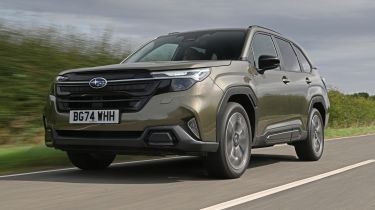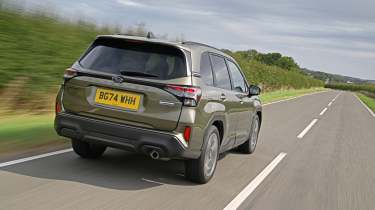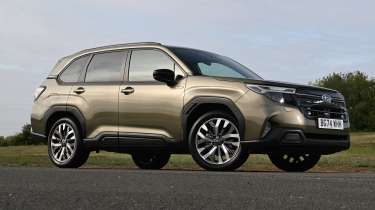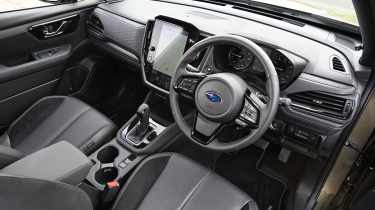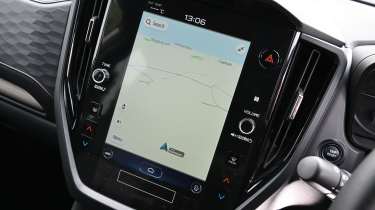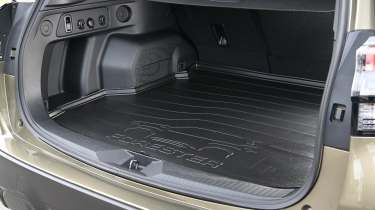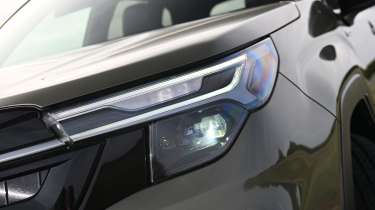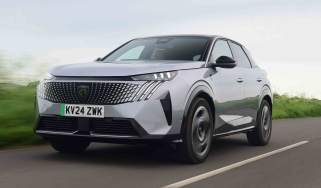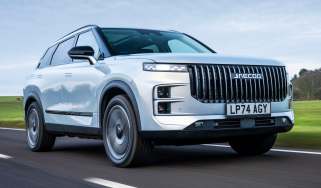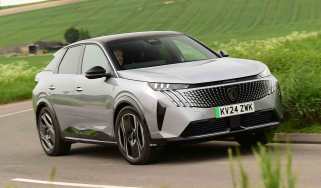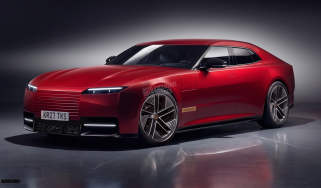Subaru Forester review
The latest Subaru Forester is an improvement over its predecessor, but it’s let down by a lack of powertrain options

Our opinion on the Subaru Forester
The Subaru Forester is a pioneering model that helped set the template for a modern compact SUV back in the mid-1990s, but the game has changed and so has the Forester. This car’s fundamentals are actually rather well sorted, with secure handling and a surprisingly comfortable ride. Those used to the plush cabins or slick digital interfaces of European and Korean rivals won’t find those things here, but in their place is a pleasing ruggedness and dependability that Subaru’s traded on for generations, and continues to do so.
About the Subaru Forester
Under the skin, the latest Forester is an evolution of the last version, but the changes are so extensive that this new model is far more than a mere facelift. The styling, interior tech, chassis and powertrain have all received extensive modifications.
For the former, the tweaks include a completely new front end, which looks much fresher and more modern than its predecessor’s, while along the sides the window line has been dropped towards the rear to improve visibility both over the driver’s shoulder and for back-seat occupants. It’s all allied to a chassis that’s 10 per cent stiffer than before, while suspension changes have reduced body sway – the cause of head shaking over big bumps.
Used - available now

2020 Subaru
Forester
33,000 milesAutomaticPetrol2.0L
Cash £21,040
2020 Subaru
Forester
46,770 milesAutomaticPetrol2.0L
Cash £17,299
2022 Subaru
Forester
17,611 milesAutomaticPetrol2.0L
Cash £23,374
2018 Subaru
Forester
81,871 milesManualDiesel2.0L
Cash £9,999The sixth-generation model joined the UK market with one hybrid-assisted powertrain in three trims, and all are extensively equipped. We’ve driven the Forester both on the international and UK launches, and we’ve pitted the Subaru Forester against the KGM Actyon in a twin test. In that test, we found that the Subaru felt more polished overall and offered superior ride quality.
Subaru Forester prices and latest deals
Prices for the Subaru Forester start from around £40,000 for the entry-level Limited model, which is our preferred trim level. In the middle of the range sits the Field trim starting from £41,600, while the top-spec Touring will set you back at least £44,100.
If you spec your perfect Subaru Forester via the Auto Express Buy a Car service, though, you can save an average of £2,000. We also have a number of new Foresters ready to hit the road, as well as some highly tempting used Subaru Forester deals.
Performance & driving experience
Pros |
|
Cons |
|
The latest Forester, as with most Subarus, features an unusual engine and powertrain layout. The four-cylinder petrol engine is horizontally opposed – also known as a boxer engine – and is similar in principle to cars such as the Porsche 718 Boxster. The benefits are largely related to a low centre of gravity and inherent mechanical balance.
True to Subaru’s heritage, the Forester comes as standard with four-wheel drive, which distributes the power in a 60:40 split, front to rear. Subaru says it has made a total of 24 revisions to the 2.0-litre flat-four powertrain, with many of these changes being aimed at improving reliability and durability, but refinement, performance, weight reduction and compliance with the latest emissions regulations have all played a part, too.
There are two driving modes to choose from, with a handy graphical readout of the car’s power curve explaining how each works. ‘Intelligent’ is the default mode, while pressing the little ‘S’ on the steering wheel engages Sport. This doesn’t increase maximum power, but it means that the driver doesn’t have to press the accelerator pedal as far, making the car feel a little more responsive under smaller throttle openings.
Unlike almost all of its four-wheel drive rivals that use set-ups that run mostly in two-wheel-drive mode, and only engage all four wheels when slip is detected, the Subaru’s is mechanically connected at all times. This has benefits for driving off-road or in slippery conditions, and is largely the reason why Subarus are so popular in cold-weather countries. While that benefit is slightly less quantifiable here in the UK, it does lend a sense of assurance in all conditions.
| Model | Power | 0-62mph | Top speed |
| Subaru Forester e-boxer | 136bhp | 12.2 seconds | 116mph |
Performance, 0-60mph acceleration and top speed
The petrol boxer engine is combined with an electric motor that adds roughly 17bhp and 66Nm of torque (driven by a 0.6kWh battery), but this assistance doesn’t come under the engine’s maximum load, so the total output is essentially the boxer unit’s maximum of 134bhp and 182Nm – the latter arriving at a fairly lofty 4,000rpm. As such, performance is a little behind the class best; 0-62mph takes 12.2 seconds and the top speed is 116mph.
The engine is quite noisy at idle, and feels laboured on the move. The hybrid tech can move the car off from a standstill, but there’s a fairly noticeable shunt from the driveline when the petrol engine engages.
The powertrain can also feel a little strained when asked for more performance, something that’s only exaggerated by the CVT transmission’s tendency to hold revs in a slightly unnatural way. If you’re used to a CVT in a hybrid Toyota, the Subaru will feel familiar. However, there are some advantages to Subaru’s combination that offer some respite from the slight frenzy of hard acceleration.
Town driving, visibility and parking
The Forester’s steering is fairly light, and by SUV standards, the chassis is quite responsive, too. Both of these things make it feel responsive and agile around town.
Country road driving and handling
Among the Forester’s finest qualities is its ride and handling balance – it ranks among the best options in the family SUV class. The suspension is a little softer than average, so there is a little more body roll through the turns than in a Volkswagen Tiguan, yet it remains agile and neutral in character. Subaru revised the steering to offer less initial resistance and a little more response and precision than in the last Forester, and it’s a positive result; the rack is nicely weighted and well judged.
That soft suspension makes it comfortable, too. It’s just a shame that the powertrain takes the shine off the overall experience.
Motorway driving and long-distance comfort
Based on feedback from owners, Subaru increased the sound deadening –especially in the roof – to reduce boominess, and it has improved “clarity of conversations” by 12.5 per cent in the rear, according to the brand. Despite this, the overriding noise in the cabin during a high-speed cruise comes from the tyres; by this measure, it’s still not as peaceful as many rivals.
While the ride remains comfortable, we found that the steering is a little vague around the straight ahead, which means that making minor corrections in a straight line isn’t quite as easy as in some alternatives.
“When testing the Subaru against its key rival from KGM, the Forester’s chassis felt sophisticated and composed, while the Actyon’s generally felt the exact opposite.” - Alex Ingram, chief reviewer.
MPG & running costs
Pros |
|
Cons |
|
The Forester’s hybrid tech doesn’t feel as involved or sophisticated as the systems that you’ll find in the likes of a Toyota RAV4, and it doesn’t really deliver results at the pumps, either. A return of 38.1mpg on our test isn’t poor, and actually beat Subaru’s official WLTP benchmark of 34.9mpg, but we’d hoped for more given that there’s little power to compensate. There are plenty of alternatives that can deliver similar or better figures while also offering much stronger performance.
| Model | MPG | CO2 | Insurance group |
| Subaru Forester e-boxer | 34.9mpg | 183g/km | 23 |
Insurance groups
There’s only one powertrain to choose from, and regardless of which of the Forester’s three trim levels you opt for, the car sits in group 23 for insurance.
Tax
We’d recommend that private buyers opt for the entry-level Limited model, because its sub-£40,000 price means it’s the only trim level to dip below the Government’s luxury car tax levy. As a result, buyers will save £425 a year from years two to six when compared with the higher trim levels.
Depreciation
The Forester is predicted to hold on to between 48 and 50 per cent of its value, depending on trim level. That’s largely on a par with some bigger-selling rivals, including the Kia Sportage, but the VW Tiguan is expected to retain approximately 52 to 58 per cent, depending on spec.
To get an accurate valuation of a specific model, check out our free car valuation tool...
Interior, design & technology
Pros |
|
Cons |
|
Subaru interiors have traditionally been fairly simple and rugged affairs, and the same can largely be said for the new generation. The difference now is that in place of the overwhelming use of scratchy and cheap-feeling plastics of its forebears, some effort has been made to use more agreeable materials that have a Toyota Land Cruiser-like sense of solidity to them.
Almost every surface is finished in a thick, rubberised-plastic trim, the sort you might find on the sole of an outdoor shoe. So while not plush or luxurious, it does feel very robust.
Interior and dashboard design
We found that sitting in a Forester feels a bit like a jump back in time – and not in a good way. Yes, there’s a large 11.6-inch touchscreen in the middle of the dashboard, but the rest of the cabin looks and feels old. A range of different surfaces contribute to a rather fussy look, and while the overwhelming majority of competitors now use a digital instrument panel, the Forester still uses traditional analogue dials for the speedometer and rev counter.
Little details that make it a more pleasant place to sit come at the top of the range. For example, plush Touring models feature a huge panoramic sunroof, which adds loads of brightness to the otherwise dark cabin.
Materials and build quality
Despite its lack of flair, there’s not much to complain about when it comes to how robust and screwed together the Forester feels overall. Rubberised materials on much of the dashboard feel like they could handle plenty of abuse, while the steering wheel buttons – and we’re happy that these are buttons, not touch-sensitive pads – all feel suitably chunky. The rest of the switchgear is solid enough, and there’s a sizeable drive selector; many rivals have swapped to smaller toggle switches.
Infotainment, sat-nav and stereo
Aside from its large 11.6-inch portrait display size, the Forester’s infotainment tech feels like it comes from a 10-year old car – and even back then, it wouldn’t have been class-leading. The graphics look blocky with messy menu layouts, the screen is very laggy when responding to touches, and loading times are slow.
Wireless smartphone mirroring is standard across the board, so while the embedded menu displays all look a little basic, this can easily be fixed by using Apple CarPlay or Android Auto. Static air-conditioning and heating controls also mean you won’t often need to dive into menus to change deeper settings, and there are still some physical controls, such as an audio volume knob and temperature controls. The screen also has an X-Mode sub-menu, giving the driver live data for vehicle angles and torque distribution – useful features for off-roading.
The steering wheel-mounted controls are a little bewildering at first, but they don’t take long to master. They also control the small driver’s info display screen sitting between a set of physical dials.
“During the Forester’s international launch, I had a chance to test its very clever driver drowsiness-monitoring tech in a controlled environment. If the sensors detect no hands on the steering wheel, an audible warning sounds which, when ignored, induces a quick jab of the brakes to try to wake a drowsy driver.” - Alex Ingram, chief reviewer.
Boot space & practicality
Pros |
|
Cons |
|
A Subaru Forester is traditionally nothing if not practical, and that’s still very much the case with the latest model. Space inside is very impressive, with plenty of room in both rows of seats. This sense of space is also visually heightened by the huge windows – Subaru has deliberately lowered the windowline by 14mm compared with the last generation. Outward visibility is excellent and makes it a very easy car to place on narrow roads.
Dimensions and size
The Subaru Forester is longer than the Hyundai Tucson at 4,670mm long, but the Tucson has a 50 litre luggage space advantage with the rear seats in place. The KGM Actyon, meanwhile, overshadows both cars with its 668 litre boot.
| Dimensions comparison | |||
| Model | Subaru Forester | Hyundai Tucson | KGM Actyon |
| Length | 4,670mm | 4,525mm | 4,740mm |
| Width | 1,830mm | 1,865mm | 1,655mm |
| Height | 1,730mm | 1,653mm | 1,670mm |
| Wheelbase | 2,670mm | 2,680mm | 2,680mm |
| Boot space | 508 to 1,731 litres | 558 to 1,799 litres | 668 to 1,780mm |
Seats & passenger space
Typical of most SUVs, the Forester has a lofty driving position that gives a great view of the road ahead. The mirrors are fairly large, and there’s plenty of glass, which means that over-the-shoulder visibility is better than in many of its rivals, too. Deep cupholders, a large glovebox and a roomy bin beneath the central armrest are all part of the plentiful storage space up front.
Our measurements showed that the Forester’s kneeroom (measured from the base of the backrest to the backs of the front seats) extends to as much as 925mm, which is a really impressive figure. Headroom is strong at 944mm, while elbow room is also generous.
The seats themselves are a little on the firm side, so passengers tend to feel slightly perched on the bench, but generous foot room means that even our tallest testers could happily stretch out. Back-seat occupants benefit from deep door bins, two cupholders in the fold-out centre armrest and dual map pockets in the back of the front seats.
Boot space
At 508 litres, the Forester’s boot isn’t as large as the Kia Sportage’s (591 litres) or the vast KGM Actyon’s (668 litres). However, that figure is still roomy; we measured the space at 920mm deep and 1,110mm wide – and that’s at its narrowest point between the wheelarches.
Drop those back seats, and the volume expands to 1,679 litres on models fitted with a sunroof, or 1,731 litres on those without. It’s easy to lower the seat backs, because there are switches in the boot and levers on the seat backs to choose from. Make sure people and delicate objects are clear when you decide to drop them, though; they spring forwards with plenty of speed when released. The boot is filled with useful hooks (including in the roof) plus a 12-volt socket.
Towing
Due to all variants being powered by the same hybrid setup, every Subaru Forester is rated to tow up to 1,870 kg braked. This is a better performance than the Hyundai Tucson’s 1,510kg limit. However, the four-wheel drive Volkswagen Tiguan can manage up to 2,200kg.
“The Subaru isn’t exactly cramped inside. Rear kneeroom is even more generous than the KGM Actyon’s, and while its 508-litre boot isn’t as big, it’s still a very reasonable size.” - Alex Ingram, chief reviewer.
Reliability & safety
Pros |
|
Cons |
|
While many UK buyers will think of world rally championship wins when Subaru is mentioned, the brand is also known for dependability. That’s proven to be the case in the 2025 Driver Power customer satisfaction survey, where Subaru secured a brilliant first place finish out of 31 manufacturers.
Safety is another detail which the brand takes very seriously, although some of the Forester’s systems seem to work better than others. For example, we found that the ‘keep eyes on road’ warning arrived a little too readily and would flash for too long on the instrument panel, and as with so many other cars on sale today, the speed limit warning would regularly pick up incorrect information and beep at us when we were obeying the correct limits.
| Euro NCAP safety ratings | |
| Euro NCAP safety rating | Five stars (2024) |
| Adult occupant protection | 83% |
| Child occupant protection | 89% |
| Vulnerable road user protection | 86% |
| Safety assist | 72% |
Buying and owning
- Best buy: Subaru Forester 2.0i Limited
The entry-level Subaru Forester is fitted with enough standard kit to keep it firmly in the running against the pricier options. However, a key draw for this car is that it just about sneaks under the Government’s luxury car tax threshold, provided you steer clear of the optional paint colours.
Subaru Forester alternatives
In the wider family SUV segment there are one or two flaws that keep the Forester from competing with the best. A better engine and gearbox combination and a more competitive price could make it a bigger player in the class.
Against the class champions, such as a Kia Sportage or Hyundai Tuscon, the Subaru isn’t as efficient or hi-tech, but hits back with a more rugged and sturdy product.
Volkswagen’s new Tiguan and the Cupra Terramar also feel more sophisticated, but you’ll have to forgo a hybrid powertrain if all-wheel drive is part of the deal. Finally, Toyota’s RAV4 and the Honda CR-V only offer four-wheel drive on their plug-in hybrid options, leaving a sizable gap for the Subaru to occupy.
Frequently Asked Questions
Subaru’s three-year, 60,000-mile warranty is a fairly underwhelming level of cover in the current market, but it is backed up by a three-year breakdown package.
